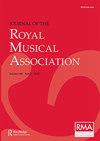How Music and Our Faculty for Music Are Made for Each Other
IF 0.5
2区 艺术学
0 MUSIC
引用次数: 0
Abstract
This study relies on the prevalence of certain structures that largely distinguish the creation and reception of music from that of language – namely, temporal grids, scalar grids, and segments with their repetitions – to construct a model of the human cognitive faculty for music that allows humans to make music the way they do. The study draws on research and thought in philosophy (including phenomenology), linguistics, psychology, and neurology, coupled with musicology, to produce a model of a human capacity to make complex comparisons between ongoing sound sequences and those simultaneously reconstructed from memory by registering the relativities within their flow. This model is then used in a consideration of how the faculty for music interacts with the faculty for language in the experience of song and a consideration of how a similar cognitive capacity for music might be identified in other species.音乐与我们的音乐教师是如何相辅相成的
本研究依赖于音乐创作和接受与语言创作和接受之间的某些结构--即时间网格、标量网格和片段及其重复--的普遍性,来构建人类音乐认知能力的模型,从而使人类能够以自己的方式创作音乐。这项研究借鉴了哲学(包括现象学)、语言学、心理学和神经学的研究和思想,并结合音乐学,建立了一个人类能力模型,通过记录声音流中的相对性,对正在进行的声音序列和同时从记忆中重建的声音序列进行复杂的比较。这个模型随后被用于研究音乐能力如何在歌曲体验中与语言能力相互作用,以及如何在其他物种中发现类似的音乐认知能力。
本文章由计算机程序翻译,如有差异,请以英文原文为准。
求助全文
约1分钟内获得全文
求助全文
来源期刊
CiteScore
0.50
自引率
0.00%
发文量
16
期刊介绍:
The Journal of the Royal Musical Association was established in 1986 (replacing the Association"s Proceedings) and is now one of the major international refereed journals in its field. Its editorial policy is to publish outstanding articles in fields ranging from historical and critical musicology to theory and analysis, ethnomusicology, and popular music studies. The journal works to disseminate knowledge across the discipline and communicate specialist perspectives to a broad readership, while maintaining the highest scholarly standards.

 求助内容:
求助内容: 应助结果提醒方式:
应助结果提醒方式:


